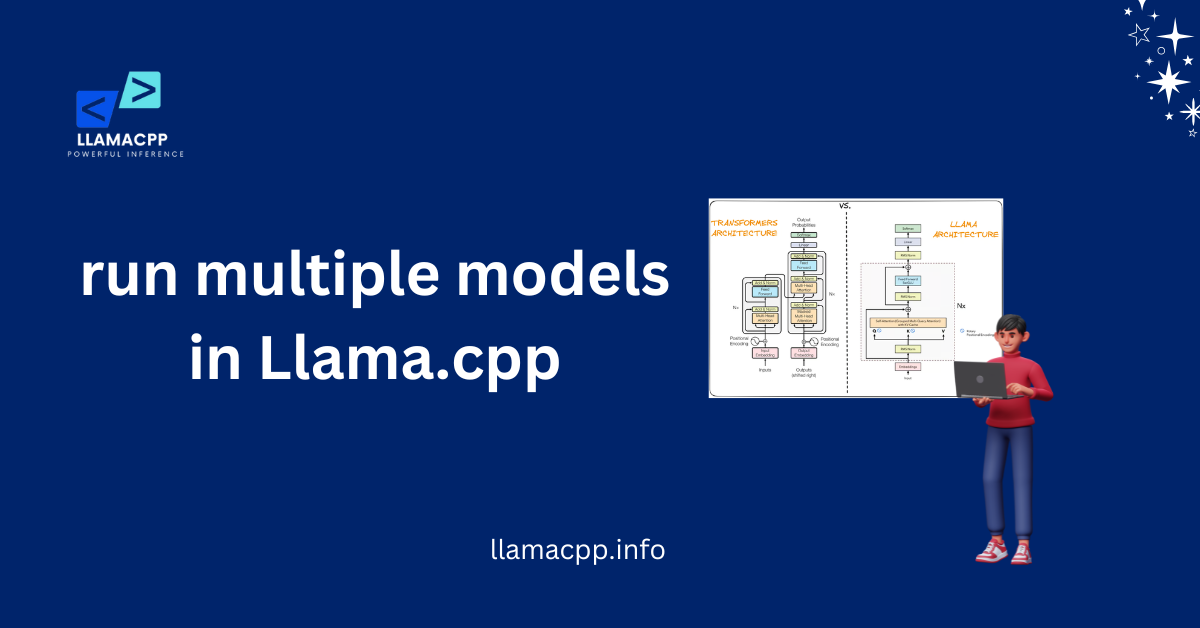Table of Contents
ToggleIntroduction
install Llama.cpp on Linux, you need to install Llama.cpp. In this tool, you can test language models or work with AI, which you enjoy. It lets you run big models without having to use heavy tools. Plus, Linux is the best platform for AI tasks. It’s fast, flexible, and has a strong group behind it. But setting it up might seem complicated if you’ve never done it before. Do not worry! This guide will be simple and easy to follow.
You don’t need to know a lot about code to begin. You can run Llama.cpp without any problems if you follow the right steps. This guide will walk you through everything. We can help you with everything from simple setup to fixing problems. It will work fine by the end with Llama.cpp.
What is Llama.cpp?
Llama.cpp is a small program that lets you run AI language models on your computer. It is open-source and built for speed. It runs on your machine instead of in the cloud like cloud-based AI does. This means you don’t need an internet connection to use it. Many people prefer it because it is simple and efficient. If you want to install Llama.cpp on Linux, you can run AI models without expensive hardware.
This tool allows you to learn and try new things. It helps users test AI models without relying on big servers. It works well on most computers as long as they are set up correctly. You can use Llama.cpp if you like AI but don’t have a powerful PC. It’s quick, safe, and simple to use. It’s easy to set up, and we’ll walk you through each step.
Why work with Llama.cpp?
A lot of people like Llama.cpp because it is quick and works with simple hardware. It can run on a weak GPU. If you put Llama.cpp on Linux, you can use AI models without making your computer run slower.
How Does Llama.cpp Work?
It uses optimized AI models to process text. When you run Llama.cpp in Python, the installation runs right on your CP, making it a making machine.
Who Needs to Use Llama.cpp?
Anyone interested in AI can use it. Many students, developers, and researchers install Llama. Cpp on Linux to test AI models. It is easy to use, works well, and is a great way to learn more about AI.
Why should you put Llama.cpp on Linux?
For AI tasks, Linux is the best pick. It’s quick, stable, and not heavy. When you install Llama.cpp on Linux, your system runs efficiently. Linux doesn’t have apps running in the background that aren’t needed as Windows does. This helps AI models do their jobs better. Many developers prefer Linux because it gives full power over system settings. It also works with AI tools, which makes it great for machine learning.
Another big reason is safety. There are no bugs or malware that can harm Linux. Your data is safe when you install Llama.cpp on Linux. You don’t have to worry about system crashes. You can get Linux for free, which saves you money and works better. Even if your computer is not very powerful, Linux can run AI models without problems.
Better Speed and Performance
Linux is designed for speed and efficiency. It does not slow down because of unnecessary tasks. When you install Llama.cpp on Linux, your AI models process faster. The system uses its resources wisely to give you the best performance.
Even if your device is old, Linux still works smoothly. AI models need a strong computing system, and Linux provides that. It ensures that even complex tasks run without delay.
More Control and Customization
Linux gives users complete control. You can change system settings to improve AI models. After you install Llama.cpp on Linux, you can adjust everything to maximize performance.
Developers love Linux because it gives them freedom. There are no forced updates or unnecessary software, which makes AI development easy.
Secure and Reliable System
Security is essential for AI tasks. Linux is safe and keeps your data protected. If you install Llama.cpp on Linux, you don’t have to worry about viruses or malware.
Linux is also very stable. It does not crash like other operating systems. You can run AI models for long hours, and you have any problems. This makes Linux the best choice for AI and machine learning.

Prerequisites for Installation
Before you install Llama.cpp on Linux, your system needs the correct setup. Without proper requirements, errors can occur. So, it’s best to prepare everything beforehand. This makes the installation process smooth and hassle-free.
Your system must be powerful enough to handle AI models. optimize Llama.cpp performance processes large amounts of data. That’s why having enough memory and the right tools is essential. Along with this, basic Linux knowledge will help in running commands. But don’t worry! Even if you’re a beginner, you can follow the steps easily.
Check System Requirements
To install Llama.cpp on Linux, check if your computer meets the basic requirements. AI models need a good processor and enough RAM. A minimum of 8GB RAM is recommended, but 16GB or more is better.
Storage space also matters. AI models take up a lot of space, so you should have at least 20GB of free space. If you’re using a GPU, make sure it supports CUDA for better performance.
Install Essential Packages
Some important software must be installed before you install Llama.cpp on Linux. These include Python, CMake, and Git. Python helps run scripts, while CMake compiles the model.
You can install them using simple terminal commands. Keeping these tools updated ensures better speed and stability. Without these, the installation might fail.
Set Up Dependencies
Llama.cpp requires some extra files to work correctly. These are called dependencies. They make AI tasks faster and more efficient.
Before you install Llama.cpp on Linux, install OpenBLAS and CUDA (if using a GPU). These improve performance and prevent crashes. Setting up the correct dependencies will make everything run smoothly.
How do I get Llama.cpp to work on Linux?
It’s easy to put Llama.cpp on Linux. Just follow these steps. Some of these are getting the things you need, setting up the environment, and installing the software. Before you start, make sure you have all the things you need.
The installation mainly involves using terminal commands. Do not worry! Each step is simple and easy to follow, and soon, you will have a Llama.cpp running on your Linux machine.
Make a copy of the Llama.cpp repository
To install Llama.cpp on Linux, you first need to get its source code. This is done using Git. Start up your terminal and type:
git clone https://github.com/ggerganov/llama.cpp.git
cd llama.cpp
This command downloads the Llama.cpp files and moves you into its folder. You’re now ready for the next step.
Run the code in Llama.cpp
It needs to be “compiled” before it can be used. This turns the source code into a program that can be run. To do this, type in the following:
make
It will take some time. After that, you’ll have a working version of Llama.cpp. The software won’t work right without this step.
Use Linux to run Llama.cpp
Now that you have loaded it, you can start using Llama.cpp. To properly install Llama.cpp on Linux, you need to load a model by running:
./main -m models/7B/ggml-model-q4_0.bin -p "Hello, how are you?"
This command checks if everything is working. If the setup is correct, you will see a response generated by the AI model. Now, you’re all set to use Llama.cpp on Linux!
Common Installation Problems and How to Fix Them
When you run Llama.cpp on Linux, errors can happen from time to time. These problems happen a lot and are easy to fix. Most issues are linked to missing dependencies, incorrect file paths, or permission errors. You can quickly resolve these mistakes if you understand them.
Don’t worry if you run into problems while installing! It can help to look at problem messages and use the right fixes. Installation problems happen often. Here’s how to fix them.
1.Missing Dependencies
To run, Llama.cpp needs specific tools. If you get a message that says files are missing, use this command to add them:
sudo apt-get update && sudo apt-get install build-essential git
This ensures that all the necessary packages are available before you load Llama.cpp on Linux. After you’re done, try running the setup again.
2.Permission Denied Error
If you receive a “permission denied” message when you run the program, it is because you do not have the proper access. To correct this, use:
chmod +x main
This command grants permission to execute the main file. You should now be able to run Llama.cpp without problems on Linux.
3.Compilation Failure
Occasionally, the make command doesn’t work. This typically occurs if your system lacks the correct compiler. Correct this by installing gcc:
sudo apt install gccOnce installed, run make again. This should successfully compile the program, completing your install Llama.cpp on Linux process.
Running Llama.cpp and Testing It
You should ensure that Llama.cpp is functional after you have installed it on Linux. Executing a few commands will assist you in verifying whether everything is correctly set up. If you find any errors, you can correct them before utilizing the tool for actual work.
After the installation is complete, testing guarantees that the program runs without problems. These are easy steps to make sure Llama.cpp is working correctly on your Linux computer.
1.Running the Basic Test
To see if Llama.cpp is working, type the following:
./main -h
This should display the help menu. If you see the available options, your install Llama.cpp on Linux process was successful. Otherwise, you should check for errors.
2.Test on a Sample Model
In order to thoroughly test the setup, load a tiny model and execute it:
./main -m models/7B/ggml-model.bin -p "Hello, Llama!"
This command will run the text through Llama.cpp. If the output looks good, your setup is ready to go, and you can now use Llama.cpp on Linux for AI purposes.
3. Performance Checking
To ensure smooth performance, monitor resource usage with this command:
htop
If the system slows down, you might need to adjust settings or upgrade your hardware. This step helps you optimize Llama.cpp on Linux for better performance.
Conclusion
As long as you take the proper steps, installing Llama.cpp on Linux is easy. Each step, from getting your system ready to run the first test, makes sure that everything goes well. Once you have successfully installed Llama.cpp on Linux, you can use it to do AI jobs, process natural language, or play around with models.
If you’re having trouble, looking at how to fix common issues can help. Llama.cpp works well because tests are run, and speed is tracked. Now that your setup is complete, you can explore its full potential and make the most of this powerful tool on Linux.
Faqs
What is Llama.cpp used for?
The open-source tool Llama.cpp is made to run AI language models quickly. It lets people read text, write replies, and play around with AI locally. Many developers and researchers use it to process natural language on Linux.
How do I get Llama.cpp to work on Linux?
To install Llama.cpp on Linux, you must first copy its source from GitHub. Then, build the source code, run the setup commands, and install any dependencies that you need. After setting it up, you can test it by adding a sample model and seeing what it says.
During startup, what should I do if something goes wrong?
Installation failures usually occur because dependencies are missing or the system is set up wrong. Make sure your system is up to date, install the tools you need, and carefully follow the compilation steps. Reading the error messages will help you quickly find and fix problems.
Can a simple Linux system run Llama.cpp?
Yes, but how well it works will depend on how much RAM and CPU power your system has. If your hardware isn’t potent, running smaller models can help. Get the most out of your system by giving it at least 8GB of RAM and a fast processor.
What can I do to make sure Llama.cpp works?
Run a test command like./main—h to make sure Llama.cpp is correct after installation. This will show you the choices you have and ensure the program is running. You can also load a test model to check that the responses work right.




















